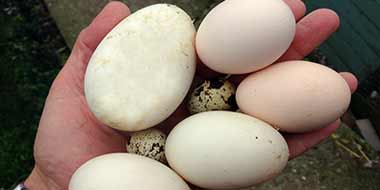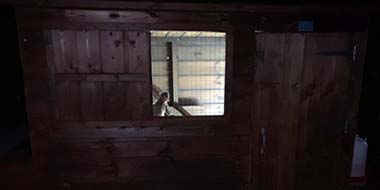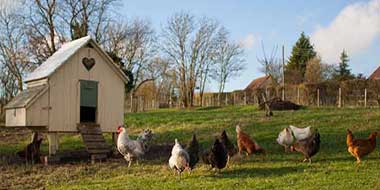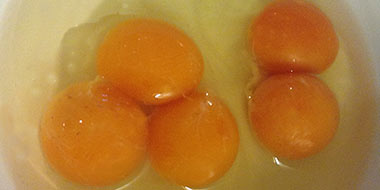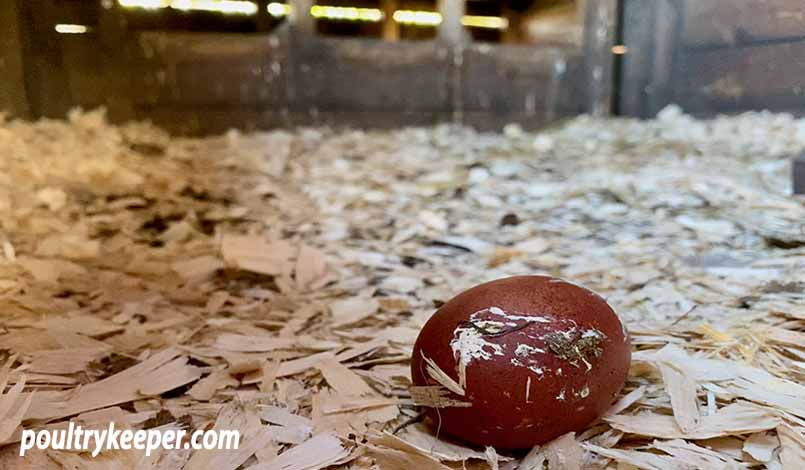
Are your chickens getting into bad habits, laying eggs on the floor instead of in their nest boxes? As well as the waste, when discarding heavily soiled eggs, this can also be a stepping stone to hens eating eggs, which is a difficult vice to cure. Worse still, egg-eating can escalate to hens breaking eggs to eat in your nest boxes.
One of the problems we sometimes face as poultry keepers is chickens laying eggs on the floor. It occurs mostly with young pullets starting to lay eggs. They often need to settle in and learn nesting behaviour.
Nesting is a learned behaviour, so once your hens establish a good routine, you shouldn’t need to worry. Still, disruption to routines (like changing chicken houses, nesting boxes or when nesting boxes get overcrowded by dominant hens) can also cause hens to break their routine and start laying eggs on the floor.
It’s not just a problem for backyard chicken keepers either; commercially, there is a move towards free-range egg production because of the increasing demand for higher welfare eggs, so egg producers are also studying chickens laying eggs on the floor and trying to encourage them to use nest boxes.
Why are chickens laying eggs on the floor a problem?
Eggs laid on the chicken coop floor can easily get soiled by faeces, causing bacterial contamination. Because of this, it is best to discard soiled eggs from the floor or hard-boil them and use them to feed your hens.
Another problem with eggs laid on the floor is that they are easily broken, which encourages egg-eating; this can be a difficult vice to cure. This is also why I suggest hard-boiling any eggs you feed to your hens and not feeding them raw.
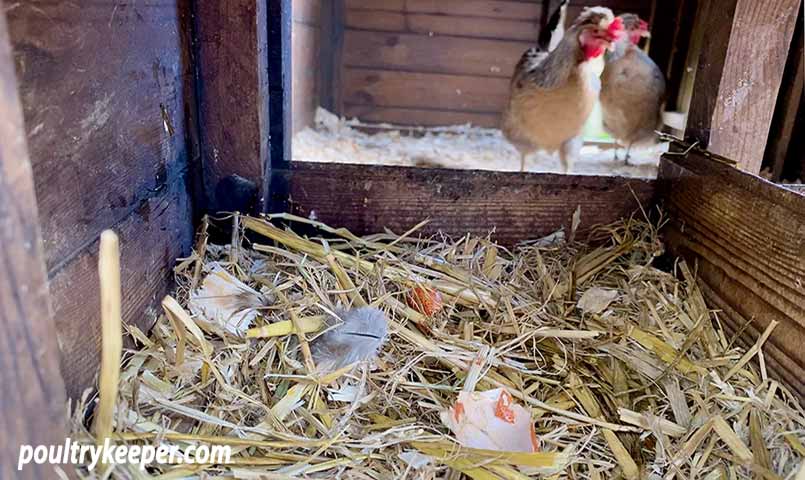
In commercial egg production, eggs normally roll out of nest boxes onto moving belts. Floor laid eggs are lower value and sent to egg-processing. It is also costly to have someone collecting them from the floor. Imagine having 50’000 hens, with 1 in 20 hens laying on the floor; that would be 2’500 eggs to collect!
I can hardly imagine it. You would certainly need big coat pockets to collect them!
Getting the right nesting box and location
Whilst the environment is certainly a factor, the amount of eggs laid on the floor does seem to depend on the hen. Some seem to have problems, while others get it. I had some Welsummer hens lay in all sorts of places, even outside the door of the coop at times, whereas the Marans that were reared with them, in the same way, would all lay in the nest boxes.
Firstly, before anything else, make sure that the nest boxes are suitable for your flock.
Nesting boxes need to be the correct size for your hens. A Brahma or Jersey Giant is considerably larger than a Pekin Bantam! A hen needs to sit comfortably in the nesting box, but if it is too big, you might get more than one hen squeezing in, which can cause eggs to be broken.
Choose a good location for your nesting boxes. Hens like privacy to lay, and the aim is to find darker areas of the hen house. They also prefer warm locations, so avoid doorways and ventilation windows that can be drafty, but remember to position nesting boxes away from direct sunlight, so they are kept as dark as possible.
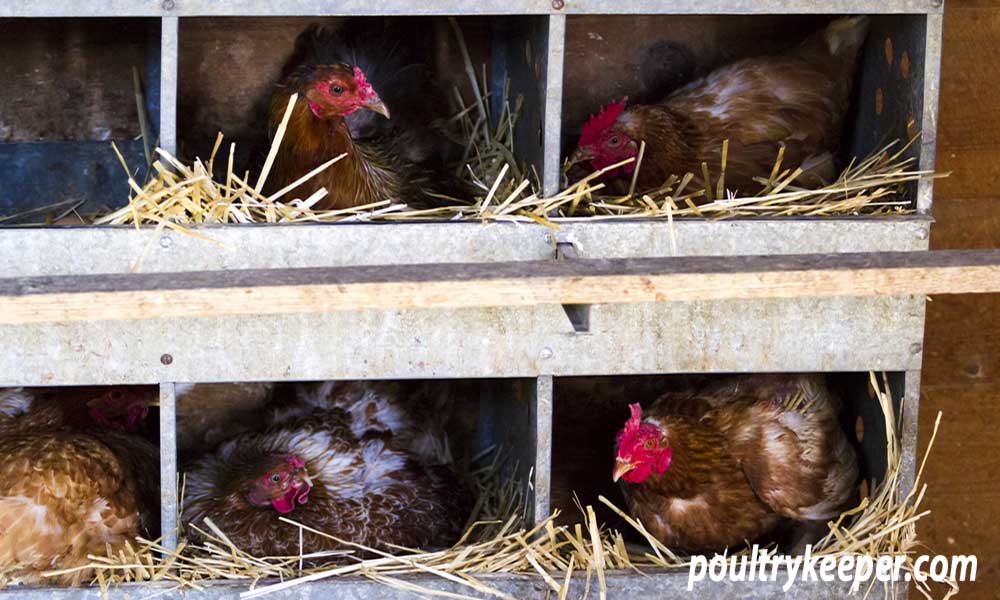
If you have purchased a nestbox, such as the ChickBox or Gaun Nestbox (two of my favourites), before you mount it on the wall of the coop, it can be a good idea to get your hens used to it on the floor. Once they are laying in the nesting box, mount it at 50cm (approximately 18 inches) from the coop floor.
Nest box locations at this height tend to work better for us than high places in the coop. If you put a nestbox too high, hens will roost in them at night, especially if they are higher than roosting bars in the coop. When hens roost in nestboxes at night, they also leave a mess that can contaminate eggs.
Chicken houses with built-in nest boxes are difficult to modify, so you can only make limited improvements. You could make them darker by hanging a piece of sacking or an old feed bag over the top half of the entrance, and improve the nesting material (a generous amount of straw is a favourite). You could also add some dummy eggs to nests.
A well-designed chicken nestbox can be found in the Omlet Eglu Cube. It is well-insulated from drafts and has a small hole for hens to enter to keep it dark and private inside. The coop floor is slatted without bedding material, so it encourages hens to go into the nesting area to lay eggs.
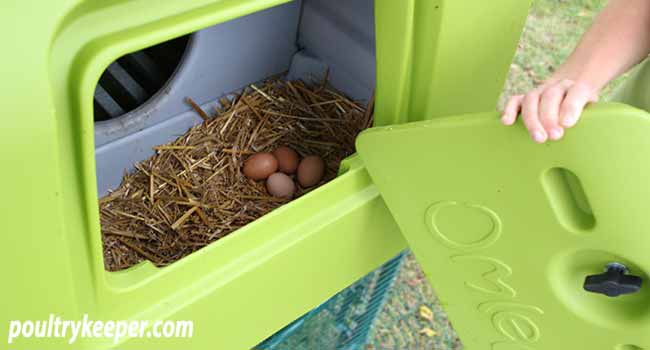
I have already written a guide on chicken nesting boxes in some detail if you need to know more. It includes the number of nest boxes you should have per hen and some dimensions if you want to build your own.
The pecking order
As you probably know, chickens in a flock have a social hierarchy we call the pecking order. This means every hen knows where it is in the flock. A hen will be submissive to hens higher in the pecking order and dominant towards hens below them.
This also means that higher-ranked hens get to eat and drink first and use the best nesting boxes. If there is a shortage of nestboxes, lower-ranking hens might not be able to lay in a nest box, leading to more chickens laying eggs on the floor.
Typical nesting behaviour
A couple of hours before laying, a pullet may visit potential nesting locations several times. This is known as pre-lay behaviour. She will choose a nesting location, much like a wild bird will find somewhere suitable to build her nest.
You may notice her going into the coop regularly to look at nests before she appears to go back to normal routine behaviour such as scratching and looking for food for a few minutes.
Some of my hens like to try out a couple of nesting boxes first, sitting in them for a few minutes. If there is one with eggs already in it, they will examine them and decide that this must be a good nest to lay in! I will often find several eggs in one nest and only a couple in the others.
Once she decides on a nest, she might move around a few times before settling. She may even pick up bits of nesting material in her beak and shape the nest by turning around to make it comfortable.
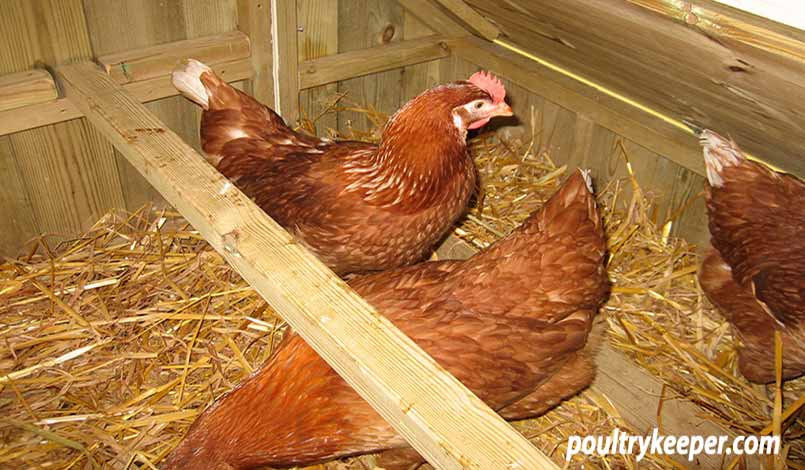
It takes a hen anything from about 15 minutes to nearly 2 hours to lay an egg once she has settled. Some hens will cackle loudly after laying to tell everyone about her egg!
It is important not to disturb or stress a hen showing pre-lay behaviour. Lifting the lid of the nesting box quickly can cause hens to leave the nest and lay on the floor when she returns.
Tips to stop chickens laying eggs on the floor
There are two angles to consider when dealing with chickens laying eggs on the floor.
- Making your nestboxes attractive to your hens.
- Remove or change other nesting locations to make them less attractive. This could be as easy as moving a feeder from the corner of the coop or blocking off an area where a hen is laying. Or, changing the bedding material can help.
We need to get a hen to break learnt behaviour and hopefully create new laying behaviour. Once this happens several times, she should have made a habit of the new behaviour.
Here are some tips to help you stop hens laying on the floor.
- Check nest box design. Consider the size, privacy and darkness.
- Hanging an old piece of sacking or feed bag over the entrance to a nest box to cover two-thirds of the entrance. Turning a chicken house around so that the nest boxes are out of direct sunlight can help stop bright sunlight from streaming in through cracks.
- Check the number of nesting boxes available at peak nesting times.
- Can the nest box location be improved? Raising a nest box slightly can make a distinction between nest and floor.
- Ensure sufficient bedding material suitable for nesting. Roll-away nests can’t have bedding material to work correctly, but can you use it until hens have learned good nesting routines?
- During warm weather, check there are no parasites, such as red mites that will stop a hen from using a nest box.
- Use dummy eggs in the nest boxes can encourage hens to lay in them.
- When chickens are laying on the floor, try to understand why they chose to lay there. Is it behind a feeder or other obstacle that we can move?
- Do not use straw or other nesting material on the chicken coop floor if hens are laying on the floor.
- Check the depth of litter on the floor. If it is too deep, hens can make nests and lay on the floor.
- Try to improve lighting on the coop floor by opening a vent or turning the pop-hole towards the sunlight.
- Ex-battery hens may not have learnt to jump up onto perches and into nest boxes. They may need re-training. A floor-mounted nest box is the best place to start, eventually lifting it higher on the wall of the coop.
Our hens form habits as young pullets during their rearing period and as they are coming into lay. We can change habits with a bit of encouragement and form new nesting habits and prevent problems escalating to egg-eating.
I hope you manage to stop chickens laying eggs on the floor. As always, I’d love your comments and feedback below.

